 |
 |
- Search
| Healthc Inform Res > Volume 17(1); 2011 > Article |
Abstract
Objectives
The purpose of this study was to develop a prototype wireless local area network (LAN)-based tracking system and evaluate its efficacy.
Methods
A wireless LAN-based tracking system was developed with a personal digital assistant (PDA) having a simple text messaging function and a prototype stand-alone tracking device. Evaluation of the effectiveness of the tracking system was performed in two ways. Twenty-five messages were sent to nurses by direct communication and 46 messages were sent by the wireless system. Thirty cases by nurses and 30 cases by the wireless system to locate hospital equipment were performed. The time required to transfer messages and to locate equipment was measured and analyzed with a Mann-Whitney test and a paired t-test, respectively.
Results
The mean time required to transfer messages by direct communication and by the wireless system were 37.92 ┬▒ 19.19 seconds and 30.65 ┬▒ 9.80 seconds, respectively which were not statistically different (p = 0.108). The mean time required to locate equipment by the nurses and by the wireless system was 234.00 ┬▒ 59.99 and 23.97 ┬▒ 6.17 seconds, respectively which was statistically different (p < 0.001).
Many hospitals are now provided with a wireless local area network (LAN) as part of the infrastructure. A wireless LAN in the hospital is usually utilized for communications, medical data transmission and patient monitoring [1]. For example, doctors and nurses can make clinical decisions more efficiently if appropriate patient information is delivered promptly via the use of a personal digital assistant (PDA) or a phone-pager. Incoming messages transmitted to a PDA are less likely to be missed and communication between healthcare workers will be improved. These applications of the use of a wireless LAN promote patient care and healthcare management.
A wireless LAN can also be used as a tracking system as access points are installed at every corner of the hospital for a constant connection. For many types of equipment in the hospital, the location should be checked routinely. For example, nurses in a ward should check the number and the location of hospital equipment such as infusion pumps, nebulizers and pulse oximeters daily, and time and cost can be saved if the equipment can be tracked electronically.
The purpose of this study was to develop a prototype of a wireless LAN-based tracking system and to evaluate its efficacy. We have focused on the time reduced by the use of the tracking system, as the system is one of the most valuable resources in healthcare management.
The tracking system consisted of four parts: wireless access points as radio beacons (WRT54G; Linksys, Irvine, CA, USA), a PDA as a probe unit (iPAQ 2490b; Hewlett-Packard, Palo Alto, CA, USA), a localization server and an administrative computer (Figure 1). Access points were located in every patient room that covered the entire area of the ward. Each access point had a unique media access control (MAC) address that distinguished the access point from other access points. The access points were not connected to the main hospital wireless network as the access points functioned as radio beacons only to measure signal strength. The PDA program received wireless signals from the access points and then sent the signal strength of the access points to the localization server every ten seconds via the main hospital wireless network (Figure 2). The localization server computed the location of each PDA by a comparison of the strength of the wireless signals with the known location of the access points. The administrative computer, which was usually located in the nursing station, was connected to the location server, retrieved the location of the PDA from the localization server and displayed the information on the monitor screen (Figure 3).
As the signal from an access point is attenuated by passage through walls, the strongest signal in a room is emitted from the access point located in the room (Figure 4). Therefore, the location of a PDA is the same as the location of the access point that showed the strongest signal to the PDA as long as all of the access points had the same output of power. In order to increase the accuracy of localization, access points were located in every patient room in the ward.
In addition to the tracking function, the system also had a simple text messaging communication function. When a text message was entered at the administrative computer, the message was instantly transferred to the target PDA with an alarm sound. The administrative computer indicated that the nurse had confirmed that the message was received when the nurse responded by clicking the OK button on the PDA screen (Figures 2, 3).
Evaluation of the efficacy of the tracking system was performed in two ways. First, the time required to send a message from the nursing station to a nurse in a patient room by direct communication and by the use of the wireless system was evaluated. From November 13 to 14, 2007, 25 messages were sent by direct communication and 46 messages were sent by the use of the wireless system. The time interval between dispatch and confirmation of the messages was measured. The mean time interval and standard deviation of each group were calculated. Statistical analysis was performed with the Mann-Whitney test with the use of SPSS ver. 12.0 (SPSS Inc., Chicago, IL, USA) and the result was considered statistically significant, if p-value < 0.05.
Second, the time required to locate hospital equipment in the ward by the nurses and the time required by the use of the wireless system was evaluated. For this study, we made a stand-alone tracking device working like a PDA program except that the time interval between the transmission of the signal strength of the access points to the localization server was set to one hour to conserve battery life (Figure 5). Any piece of equipment could be tracked and located as long as the tracking device was attached to the equipment. From April 16 to 23, 2008, 30 cases were performed both by the nurses and by the use of the wireless system. The time delay to locate hospital equipment was measured. The interval of five months between the two studies was due to the development of stand-alone tracking devices. The mean time delay and standard deviation of each group were calculated. Statistical analysis was performed with use of the paired t-test using SPSS ver. 12.0 and the result was considered statistically significant, if p-value < 0.05.
The mean time interval and standard deviation from dispatch and confirmation of the messages by direct communication and by the use of the wireless system were 37.92 ┬▒ 19.19 seconds and 30.65 ┬▒ 9.80 seconds, respectively. The mean time interval was not statistically significantly different between the two groups (p = 0.108). The mean time delay and standard deviation to locate equipment by the nurses and by the use of the wireless system were 234.00 ┬▒ 59.99 seconds and 23.97 ┬▒ 6.17 seconds, respectively. The mean time delay was statistically significantly different between the two groups (p < 0.001) (Table 1, Figure 6).
Wireless LAN is used in healthcare institutions and works as part of the infrastructure. A hand-held computerized device and PDA can assist in medical decision making in an emergency with point-of-care documentation [2,3]. Many medical instruments include a wireless LAN interface or a slot where one can be plugged-in to deliver data to the hospital network [4]. Medical images can be transferred via the wireless LAN by virtue of its high data transfer rate [5]. Some types of hands-free communication systems are based on the use of a wireless LAN and the systems enable in-building mobile workers to communicate instantly with one another while working [6]. With the wireless LAN-based tracking system, although the time required to transfer a message to a nurse was not decreased statistically significantly, the time required to locate hospital equipment was decreased statistically significantly. However, as each message transfer pulls at least one nurse away from his or her task, it can be considered that the time required to transfer the message is actually saved with the use of the tracking system.
Nurses usually spend time by handling medical records, handling calls pertaining to patient status and location and communicating with patients, doctors and other nurses. These diversions possibly result in paying less attention to patient care. As our system saves time for nurses to spend on communicating with other nurses and to locate hospital equipment, more time and attention can be paid to patient care and safety. In addition, text messaging with the use of a PDA also reduces overhead paging, making the environment quieter.
There are some limitations to this study. First, there is always the possibility of a localization error because of background noise and the time variability of the wireless signals. In order to minimize localization errors and to maximize room-level performance, the access points were located in every patient room that covered the entire area of the ward. If zone-level localization performance was sufficient for clinical application, fewer access points would be necessary.
Second, this study was performed in a ward covering only a single floor. If the tracking system is applied to cover the whole area of the hospital, too many access points acting as radio beacons will be needed and possibly interfere with the Wi-Fi infrastructure of the hospital. Further study should be done for less access points and minimal Wi-Fi interference in this situation.
Third, the tracking was not real-time. The connection intervals to the localization server were ten seconds for a PDA and one hour for the stand-alone tracking device. There were a few localization errors detected in the preliminary study as the connection interval of the PDA was initially set to three minutes, which was too long to track nurses in real time. This problem was solved by changing the connection interval of the PDA to ten seconds. However, there was no significant localization error in tracking the stand-alone tracking device in spite that the connection interval was one hour, as the tracking device was attached to the equipment in which the location was usually not changed.
Fourth, the stand-alone tracking device requires regular battery recharging. Our prototype tracking device has a built-in lithium-polymer battery and needed to be recharged periodically. While recharging, the tracking device is not temporarily usable and the equipment to which the tracking device is attached cannot be tracked. This problem can be solved by the use of a replaceable battery. The tracking device will be available without interruption by replacing discharged batteries with fully charged supplemental batteries. If the connection interval of the tracking device decreases, the battery life will decrease and the recharging interval should be reduced for continuous service. Therefore, the balance between the connection interval and the battery life is important and the connection interval should be modified to the clinical situation when the tracking system is applied.In spite of these limitations, we believe that the wireless LAN-based tracking system can be used in other departments in the hospital. As the tracking system is able to track and locate any type of equipment or person to which the tracking device is attached, it can also be used to track patients and equipments in the operating room (OR) or emergency room (ER). If the tracking system is used to track unique or critical equipment in the OR or ER, staff members can easily locate the equipment with less time spent, and the departments in the OR or ER will be able to share the equipment.
The use of a wireless LAN-based tracking system can save time for nurses to communicate and to check equipment in wards and therefore allows nurses to pay more time and attention to patient care and safety.
Acknowledgements
This work was supported by a Korea Science and Engineering Foundation (KOSEF) grant funded by the Korean Government Ministry of Science and Technology, MOST (No. R01-2006-000-10298-0).
References
1. Heslop L, Howard A, Fernando J, Rothfield A, Wallace L. Wireless communications in acute health-care. J Telemed Telecare 2003;9:187-193. PMID: 12952687.


2. Bird SB, Zarum RS, Renzi FP. Emergency medicine resident patient care documentation using a hand-held computerized device. Acad Emerg Med 2001;8:1200-1203. PMID: 11733302.


3. Eastes L. Use of the personal digital assistant for point-of-care trauma documentation. J Emerg Nurs 2001;27:516-518. PMID: 11577299.


4. Traherne R, Diston A. Wireless technologies in health care. Med Device Technol 2005;16:35-37. PMID: 16334604.


5. Yoshihiro A, Nakata N, Harada J, Tada S. Wireless local area networking for linking a PC reporting system and PACS: clinical feasibility in emergency reporting. Radiographics 2002;22:721-728. PMID: 12006700.


6. Breslin S, Greskovich W, Turisco F. Wireless technology improves nursing workflow and communications. Comput Inform Nurs 2004;22:275-281. PMID: 15520597.


Figure┬Ā1
A diagram representing the components and localization process of the tracking system. The PDA receives signals of the access points (AP) and sends the signal strength to the localization server. The localization server computes the location of the PDA and the administrator computer displays the location on the monitor screen.
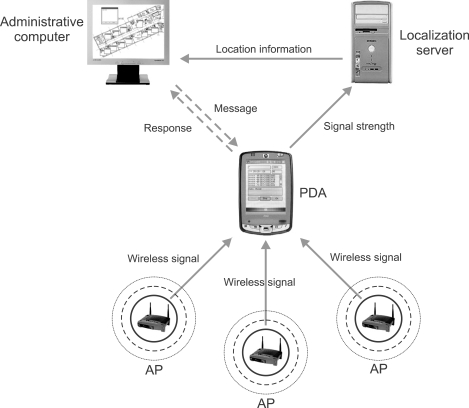
Figure┬Ā2
Screen capture of the PDA screen. The prototype of the PDA program shows the MAC address and signal strength of each access point for the purpose of debugging. When the administrative computer sends a message to the PDA, the message appears in the textbox with an alarm sound and the OK button becomes enabled. If a user clicks the OK button, the administrative computer indicates that the message has been successfully transmitted and the user confirmed that the message was received.
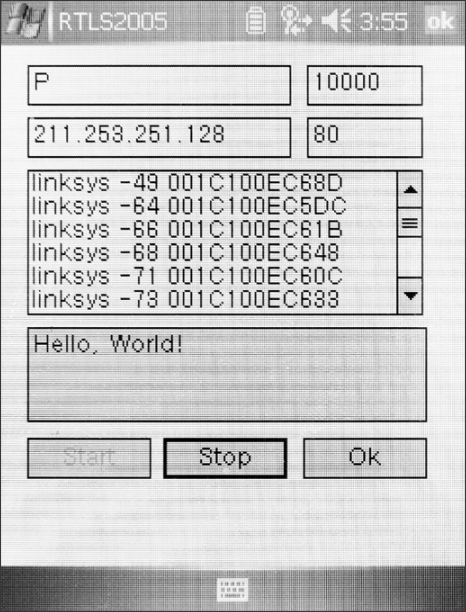
Figure┬Ā3
Screen capture of the administrative computer. Each PDA is marked as an icon with an alphabetical character on the screen. Each icon appears at the window titled with the patient room number where the corresponding PDA is located, allowing easy recognition. A message can be entered in the pop-up window that appears by double clicking the PDA icon.
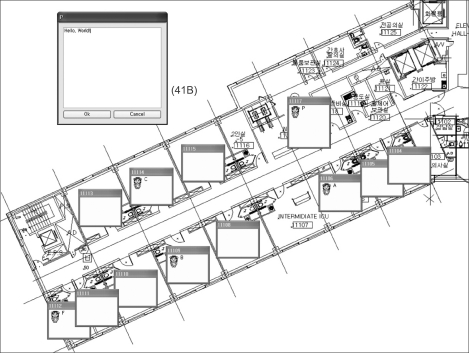
Figure┬Ā4
Signal strength profile measured in the patient rooms. The signal from an access point is strongest at the room where the access point is located and gradually weakens as the distance increases. Signal strengths were measured with a laptop computer having IEEE 802.11g wireless connectivity and a scanning program (NetStumbler 0.4.0; http://www.netstumbler.com/downloads/). Each value of signal strength was averaged from four measurements with a few seconds interval in order to compensate for the time variability of the wireless signals.
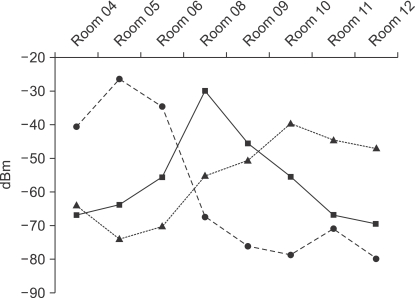
Figure┬Ā5
Pictures of a stand-alone tracking device. The tracking device can be attached to any equipment, which can be tracked and located as long as the tracking device is attached to the equipment.
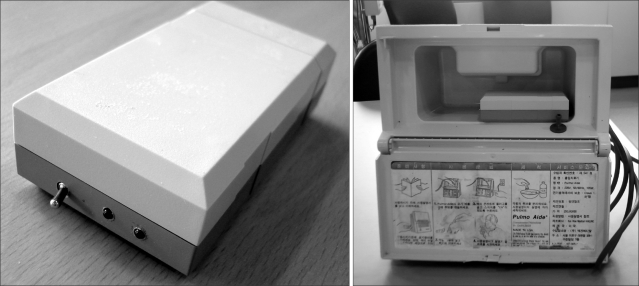
-
METRICS

-
- 2 Crossref
- 3,380 View
- 29 Download
- Related articles in Healthc Inform Res
-
Clinical Nursing Process Model using a Database Linking System2003 March;9(1)







